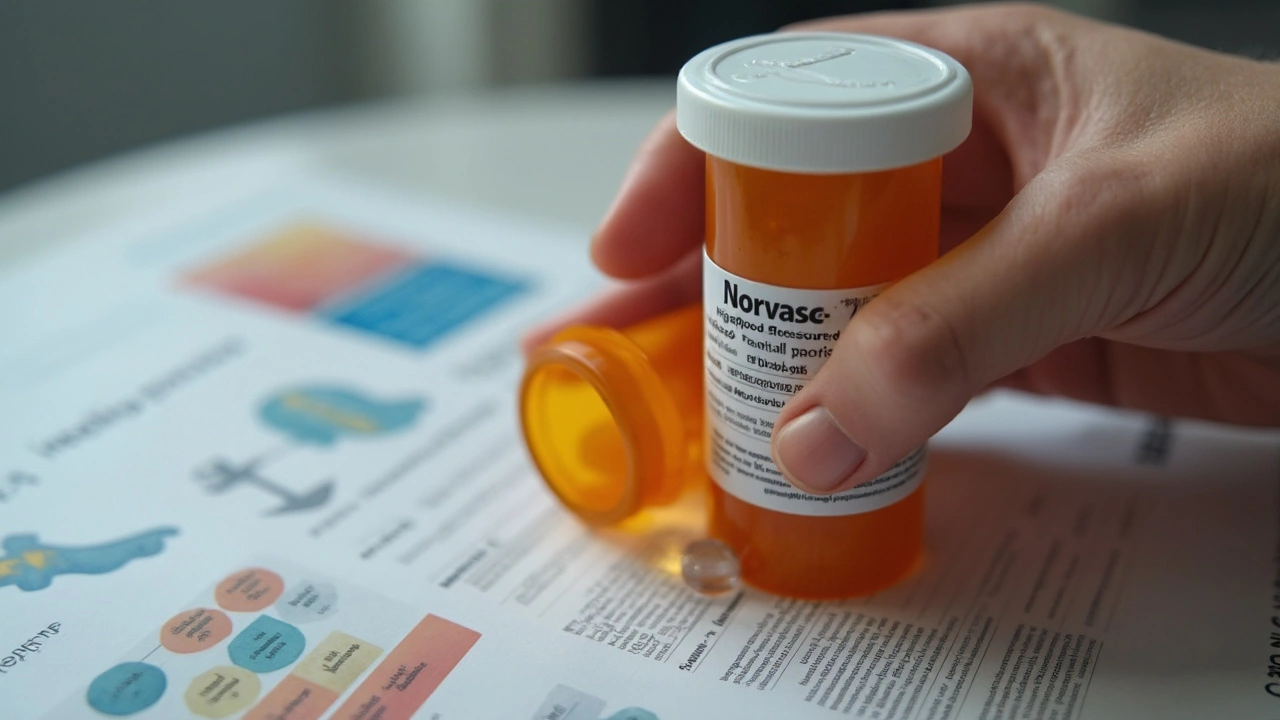Every few seconds, someone is told their blood pressure is too high. You barely notice your heart pounding in your chest when life’s calm, but when those numbers edge up to the danger zone, doctors spring into action. And when they grab their prescription pads, one name shows up a lot: Norvasc. If you’ve ever seen this little pill in your pillbox, you probably wondered if it’s doing more than just messing with your blood pressure. Is it safe for the long haul? Do most people feel okay on it? And what’s actually happening inside your body when you swallow that tablet every morning?
What Exactly Is Norvasc and Why Do Doctors Love It?
Norvasc is the brand name for amlodipine, a medication that doctors hand out like candy when they spot high blood pressure or certain types of chest pain (they call that angina, but nobody uses that word outside the clinic). Norvasc sits right in the family of drugs called calcium channel blockers. The big idea here is simple: It makes your blood vessels relax, which means the blood can flow more easily. This little change takes a load off your heart and drops those scary numbers on the BP cuff.
If you want numbers, here you go: In the United States, Norvasc is among the top three most prescribed blood pressure meds, with about 40 million prescriptions filled in 2024. Doctors favor this one because it’s long-acting, which means one pill is good for a full day—no awkward lunch-hour doses, no early-morning fog trying to remember if you took your meds. And unlike some other options, Norvasc usually doesn’t mess with your potassium levels or make you pee every 30 minutes, so it wins points in the convenience department.
What does Norvasc actually do? It keeps calcium from entering the muscle cells of your heart and blood vessels. Less calcium means less squeezing. That’s a good thing if your heart’s working overtime. People with hypertension—defined as blood pressure readings consistently above 130/80 mmHg—actually have stiffer, narrower arteries. Norvasc helps to reverse that trend, meaning it can help prevent strokes, heart attacks, and kidney damage over time. It doesn’t cure high blood pressure, but it gives you a fighting chance to keep things under control while you work on the basics: diet, exercise, and maybe a little less arguing with your boss.
Taking Norvasc: Dosage, Safety Tips, and What to Expect
Pop quiz: What’s the most common Norvasc dose for adults with high blood pressure? If you said 5 mg once daily, you nailed it. Some people start even lower—2.5 mg a day—if they’re old, frail, or have liver issues. For chest pain, docs might bump it up to 10 mg if needed. But here’s where things get real: different bodies, different reactions. Never adjust your dose just because a neighbor told you, "It worked for me!" Stick to your doctor’s plan, no improvising.
Pro tip: Take Norvasc at the same time every day, with or without food. Missing doses isn’t the end of the world, but try not to make a habit of it. Skipping pills over and over raises your risk of sudden blood pressure spikes. And don’t stop abruptly without checking with your doctor, because your heart might not love that.
If you want to see results—meaning, fewer headaches, easier breathing during chores, or better energy—give it a few weeks. The numbers in your doctor’s office might budge earlier, but how you feel can take longer. If you don’t notice big changes right away, don’t stress. The main magic is happening silently: reducing your risk for heart issues before they even start.
| Condition | Starting Dose | Maximum Dose |
|---|---|---|
| Hypertension (adults) | 5 mg daily | 10 mg daily |
| Hypertension (children 6-17) | 2.5-5 mg daily | 5 mg daily |
| Angina | 5-10 mg daily | 10 mg daily |
A few tips for the road:
- If you forget a dose, take it when you remember. But if it’s almost time for your next dose, skip it—never double up.
- Keep your pills in the original bottle, away from heat and moisture. No, your car glovebox is not a safe place.
- Alcohol can make you dizzy faster, so go slow and see how you react.
- If you have liver disease, remind your doctor—Norvasc can hang around longer in your system.

Side Effects: The Good, the Bad, and How to Handle Them
No pill is perfect (if only), and Norvasc comes with its own list of possible side effects. Most people do fine—seriously—but there are a few things to watch for. You might notice a little ankle swelling, especially by the end of the day. That’s Norvasc’s way of relaxing your blood vessels, but sometimes it goes a bit too far in the legs. Feet looking like puffy bread loaves? Call your doctor and ask about adjusting the dose or timing.
Some people feel dizzy, tired, or get a mild headache for the first few weeks. These usually get better as your body adjusts. If you stand up too fast, you might feel a little lightheaded. Easy fix? Stand up slowly—and put away the stepstool for a few days. On rare occasions, people report palpitations (your heart skipping or pounding), or flushing (hello, sudden warm face). If you get chest pain that’s new or worse, don’t be a hero; call for help.
For anyone worried about weight gain: Most users report little or no change. Studies haven’t shown a direct link between Norvasc and gaining weight. Some fluid may stick around, but it’s usually mild and goes away if the dose is adjusted.
The good news: Side effects often fade with time. But if you get anything truly weird—like severe swelling, yellowing eyes, or rashes—stop taking the pill and call your healthcare provider, even if it’s a Saturday.
| Side Effect | % of Patients Affected |
|---|---|
| Ankle Swelling (Edema) | 9-18% |
| Headache | 7-12% |
| Fatigue | 6-9% |
| Dizziness | 2-5% |
| Flushing | 2-4% |
| Heart Palpitations | Less than 2% |
Ever heard of grapefruit and meds not mixing? Norvasc isn’t as fussy as some others, but go easy on the grapefruit just to be safe. If you’re already on other blood pressure meds, let your doctor know. Combining pills can up your risk of side effects if not managed carefully.
FAQs, Real Stories, and Smart Advice for Norvasc Users
If you hang out in online forums or chat with neighbors, you’ll hear all kinds of Norvasc stories. Some people swear it changed their lives—no more chest pain, steady BP, and more energy for gardening or chasing grandkids. Others aren’t sure it’s working or feel annoyed by swollen ankles. Doctors like Norvasc because the science backs it up: In 2024, a major review found that amlodipine reduced the risk of stroke by about 38% compared to people not taking it. That’s a solid reason to stick with it unless your side effects become unbearable.
One 67-year-old woman I chatted with, who’s been on Norvasc for three years, said it’s become “just like brushing her teeth—just something that keeps her going.” But she also confessed she didn’t take her medication seriously until she landed in the ER with chest tightness, a reminder that the stakes can be serious if you mess around with doses.
- Don’t expect instant miracles. Give it a few weeks to kick in; your blood pressure isn’t going to normalize overnight.
- Get your blood pressure checked at home. Many pharmacies will even help you pick the right cuff.
- If your doctor wants bloodwork, don’t skip it. This helps catch any rare issues early.
- Tell your provider if you’re pregnant or thinking about it—Norvasc isn’t recommended for pregnant women.
- If you’re on other meds, especially for heart or kidney issues, bring them all to appointments so your doctor can check for interactions.
There’s more than one way to manage high blood pressure. Norvasc is just one tool in a big medical toolbox. Still, it’s a big one—hundreds of clinical trials and millions of users say it’s reliable, easy to use, and protective against the nastiest heart complications. It doesn’t replace healthy living, but for many, it’s the silent partner making sure the heart’s quiet work keeps going day and night.



Norvasc isn't magic-it's physics. Calcium channels are like tiny gates, and amlodipine just holds them open so blood doesn't have to fight through narrow pipes. But nobody talks about how this drug turns your legs into water balloons. I've seen people waddle out of the pharmacy like they're carrying two watermelons in their socks. The science checks out, but the side effects? That's where the real story begins.
Ive been on this for 2 years and honestly it saved my life no more dizzy spells no more chest tightness just chillin and taking my pill like a champ
I love how this post breaks it down without scare tactics. My dad started on 2.5mg after his kidney test came back weird and he’s been stable for 18 months. He still forgets sometimes but we put his pills in a little box with the days labeled. Simple stuff works.
40 million prescriptions? That’s not a sign of effectiveness-that’s a sign of lazy medicine. Why not just tell people to eat less salt and walk more? But nah let’s hand out pills like candy and call it a day. I’ve got a cousin who got off Norvasc and started doing yoga and his BP dropped 20 points. No drug needed.
It’s funny how we treat hypertension like a personal failure. We don’t blame people for having diabetes because of genetics, but high BP? Oh, you must be lazy. The truth is, our bodies are just responding to decades of processed food, stress, and sitting. Norvasc doesn’t fix the root-it just lets us keep living like we always have. I’m not against it, I’m just tired of pretending it’s a cure.
In India we call this medicine amlodipine. Same thing. My aunt takes it and her ankles swell but she says better than fainting at the market. She walks every morning now. Small changes matter more than pills.
Let’s be real. Big Pharma paid off every cardiologist in the country to push this. You think they care about your heart? They care about your subscription. And that ankle swelling? That’s not a side effect-that’s a warning sign your body’s rejecting the chemical cage they locked you in. Read the clinical trial data. The stroke reduction? It’s statistically significant but clinically negligible if you’re not smoking or eating junk. They sold you a placebo with side effects.
Oh for fuck’s sake. Another post about how Norvasc is the holy grail of hypertension. I’ve got a mate in Brighton who’s been on it for five years and now he can’t climb stairs without looking like he’s been hit by a truck. Swollen ankles, constant fatigue, and he still drinks three pints a night. This isn’t medicine-it’s a bandaid on a hemorrhage. Why don’t we just call it what it is: a chemical pacifier for people who won’t change their lives?
I’ve been on amlodipine for seven years now. Started at 5mg, went up to 10 when my BP crept up after I gained weight from stress-eating during the pandemic. The swelling was real-felt like I was wearing concrete boots by 6pm. But I started walking after dinner, cut out the chips, and within a month the puffiness went down. The drug didn’t fix me. I did. It just gave me the breathing room to get started. Don’t hate the tool, hate the habit you refuse to change.
I think people forget this is a chronic condition. You don’t cure high blood pressure like a cold. You manage it. Norvasc isn’t the villain. The real villain is the idea that one pill should fix everything. It’s a tool. Like a wrench. You don’t blame the wrench when you don’t fix the engine. You blame the guy who never turned the screw.
The pharmacokinetics of amlodipine are well-documented: half-life of 30–50 hours, high bioavailability, minimal CYP3A4 interaction. It’s a dihydropyridine calcium channel blocker with selective vascular action. The 9–18% edema rate is consistent across meta-analyses. What’s rarely discussed is that edema correlates with BMI and sodium intake. The drug isn’t the problem. The context is.
Ive read the studies and the FDA filings and let me tell you this drug is a joke. They downplay the edema and ignore the fact that long term use increases risk of heart failure in patients with preexisting LVH. And dont even get me started on the profit margins. Amlodipine costs 3 cents a pill and they charge 12 bucks. Thats not healthcare thats extortion.
My sister took this and got so dizzy she fell down the stairs. Now she’s on a different med and her BP is better. So yeah maybe it works for some but dont assume it works for everyone. Listen to your body not the internet
This whole post reads like a pharmaceutical ad disguised as public health advice. We’re not talking about a miracle drug here-we’re talking about a chemical that lets people keep living like they’re in a fast food commercial. Meanwhile, countries with lower BP rates don’t hand out pills like free candy. They serve vegetables. They walk. They sleep. But no, let’s keep selling convenience over competence.
I’ve been on Norvasc for 4 years. The swelling was bad at first. I started elevating my legs at night and cutting salt. It got better. I still take it because I don’t want to end up like my dad. He refused meds and had a stroke at 62. This pill isn’t perfect. But it’s the reason I’m here to type this.
You people are so naive. Norvasc doesn’t lower blood pressure-it lowers your awareness. You feel fine so you think you’re fine. But your arteries are still stiff. Your heart is still working overtime. The drug just masks the symptoms so you can keep eating pizza and scrolling TikTok. You’re not healing. You’re numbing.
I read this whole thing and all I could think was-why isn’t anyone talking about the emotional toll? My brother took Norvasc for a year. He got so tired he stopped playing guitar. He stopped hanging out. He said he felt like he was living underwater. He didn’t say it was the drug-he just said he was ‘burnt out.’ But I know. I’ve seen it before. The meds don’t just change your body-they change your soul. And nobody talks about that.